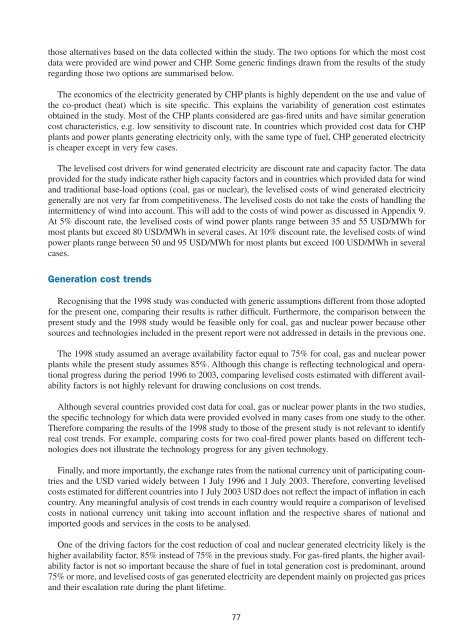Projected Costs of Generating Electricity - OECD Nuclear Energy ...
Projected Costs of Generating Electricity - OECD Nuclear Energy ...
Projected Costs of Generating Electricity - OECD Nuclear Energy ...
Create successful ePaper yourself
Turn your PDF publications into a flip-book with our unique Google optimized e-Paper software.
those alternatives based on the data collected within the study. The two options for which the most cost<br />
data were provided are wind power and CHP. Some generic findings drawn from the results <strong>of</strong> the study<br />
regarding those two options are summarised below.<br />
The economics <strong>of</strong> the electricity generated by CHP plants is highly dependent on the use and value <strong>of</strong><br />
the co-product (heat) which is site specific. This explains the variability <strong>of</strong> generation cost estimates<br />
obtained in the study. Most <strong>of</strong> the CHP plants considered are gas-fired units and have similar generation<br />
cost characteristics, e.g. low sensitivity to discount rate. In countries which provided cost data for CHP<br />
plants and power plants generating electricity only, with the same type <strong>of</strong> fuel, CHP generated electricity<br />
is cheaper except in very few cases.<br />
The levelised cost drivers for wind generated electricity are discount rate and capacity factor. The data<br />
provided for the study indicate rather high capacity factors and in countries which provided data for wind<br />
and traditional base-load options (coal, gas or nuclear), the levelised costs <strong>of</strong> wind generated electricity<br />
generally are not very far from competitiveness. The levelised costs do not take the costs <strong>of</strong> handling the<br />
intermittency <strong>of</strong> wind into account. This will add to the costs <strong>of</strong> wind power as discussed in Appendix 9.<br />
At 5% discount rate, the levelised costs <strong>of</strong> wind power plants range between 35 and 55 USD/MWh for<br />
most plants but exceed 80 USD/MWh in several cases. At 10% discount rate, the levelised costs <strong>of</strong> wind<br />
power plants range between 50 and 95 USD/MWh for most plants but exceed 100 USD/MWh in several<br />
cases.<br />
Generation cost trends<br />
Recognising that the 1998 study was conducted with generic assumptions different from those adopted<br />
for the present one, comparing their results is rather difficult. Furthermore, the comparison between the<br />
present study and the 1998 study would be feasible only for coal, gas and nuclear power because other<br />
sources and technologies included in the present report were not addressed in details in the previous one.<br />
The 1998 study assumed an average availability factor equal to 75% for coal, gas and nuclear power<br />
plants while the present study assumes 85%. Although this change is reflecting technological and operational<br />
progress during the period 1996 to 2003, comparing levelised costs estimated with different availability<br />
factors is not highly relevant for drawing conclusions on cost trends.<br />
Although several countries provided cost data for coal, gas or nuclear power plants in the two studies,<br />
the specific technology for which data were provided evolved in many cases from one study to the other.<br />
Therefore comparing the results <strong>of</strong> the 1998 study to those <strong>of</strong> the present study is not relevant to identify<br />
real cost trends. For example, comparing costs for two coal-fired power plants based on different technologies<br />
does not illustrate the technology progress for any given technology.<br />
Finally, and more importantly, the exchange rates from the national currency unit <strong>of</strong> participating countries<br />
and the USD varied widely between 1 July 1996 and 1 July 2003. Therefore, converting levelised<br />
costs estimated for different countries into 1 July 2003 USD does not reflect the impact <strong>of</strong> inflation in each<br />
country. Any meaningful analysis <strong>of</strong> cost trends in each country would require a comparison <strong>of</strong> levelised<br />
costs in national currency unit taking into account inflation and the respective shares <strong>of</strong> national and<br />
imported goods and services in the costs to be analysed.<br />
One <strong>of</strong> the driving factors for the cost reduction <strong>of</strong> coal and nuclear generated electricity likely is the<br />
higher availability factor, 85% instead <strong>of</strong> 75% in the previous study. For gas-fired plants, the higher availability<br />
factor is not so important because the share <strong>of</strong> fuel in total generation cost is predominant, around<br />
75% or more, and levelised costs <strong>of</strong> gas generated electricity are dependent mainly on projected gas prices<br />
and their escalation rate during the plant lifetime.<br />
77

















